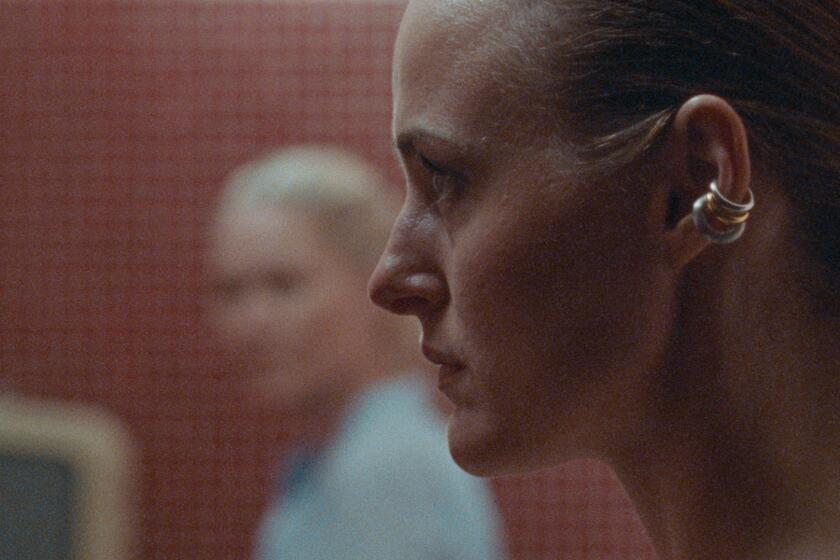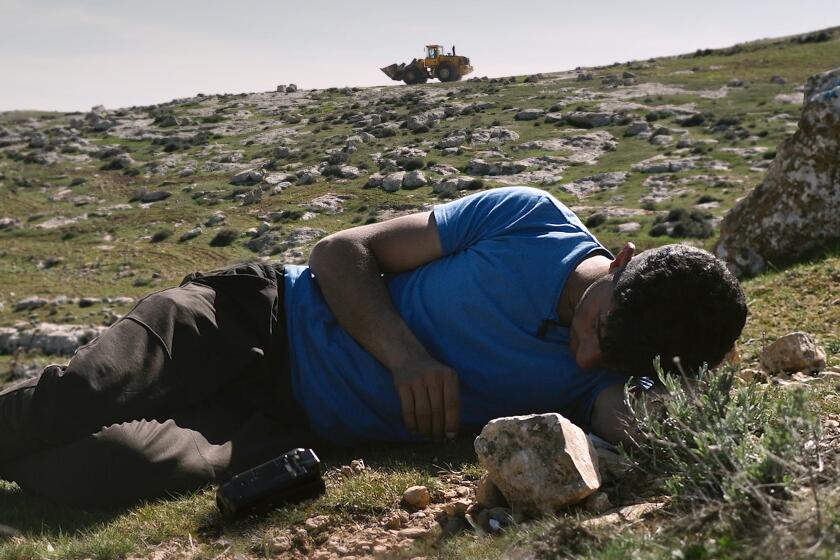Jarmusch’s tobacco road
- Share via
Anyone who spent time riding in New York’s subway system from the mid-’70s to the mid-’80s would recognize independent film director Jim Jarmusch -- assuming, of course, they knew who he is and what he looked like. However, to know who he is is to know what he looks like. It’s the hair, which is white and goes straight up, and a demeanor that’s been described as “Zeus on acid.” He’s a laconic reminder of Lower Manhattan cool.
“In the mid-’70s,” Jarmusch says of his period of greatest ridership, “I had a job as a process server for Legal Aid, so I would have to go to court every day to pick up papers, and then I’d have to go to the Bronx or Brooklyn or Queens and then back to Manhattan. I memorized the subway system.”
Jarmusch, who could still be found underground even when he became a filmmaker, is less visible now. He spends part of his time in upstate New York, and he hasn’t had a film out in five years. In fact, when his new movie, “Coffee and Cigarettes,” premiered at the Toronto International Film Festival last fall, a film industry reporter was heard to say, “Nobody will pick up that movie. No one is interested in Jarmusch.” He was wrong on both counts. The film was picked up by MGM/UA and released last week. It also appeared at this year’s Tribeca Film Festival.
When apprised of the reporter’s comment, Jarmusch laughs ruefully and says, “I’m not a player, and I don’t do things through studios. I am marginal. At the same time, if you go to South America or Europe or Asia, I am a film director, I’m not a cult film director. I have no control over those things, and ultimately they’re not my concern, because I don’t make films to make money. I just make films.”
“Jim’s whole approach is that he has not compromised in any way,” says Bingham Ray, the former MGM/UA exec who acquired “Coffee” and used to sneak Jarmusch and his “grungy, dirty, punk rock” friends into New York’s Bleecker Street Cinema when he was a programmer there 20 years ago. “That in itself is so rare that it hardly ever happens. If he’s not a name brand at the multiplex, so what? His films hold up. They stand the test of time.” However history judges Jarmusch’s recent, more esoteric films “Dead Man” (1998) and “Ghost Dog: The Way of the Samurai” (1999), “Coffee” remains his most accessible film in years, a throwback to his first two films, “Stranger Than Paradise” (1986) and “Down by Law” (1988). It also exploits his strengths as an episodic filmmaker, which he previously deployed in “Mystery Train” (1989) and “Night on Earth” (1991).
“Coffee” is a collection of 11 vignettes centered on two or three people gabbing about -- and ingesting -- the title substances. It features the Jarmusch sensibility at full flower: characters whose exchanges are rife with miscommunication, pointlessness, absurdity.
In keeping with the film’s unorthodox structure, it was made over a 17-year period, beginning in 1986 with a short commissioned by “Saturday Night Live” that featured Steven Wright, with Roberto Benigni as a character whose grasp of English -- and reality -- prompts such lines as “Do you know my mother?” With a few exceptions, each of the shorts was shot in one day, which Jarmusch says he found freeing. The exercise also helped keep him sharp when other, larger projects were languishing.
Jarmusch says he hadn’t intended to make a film out of the premise. But after finishing two shorts called “Coffee and Cigarettes,” he decided to continue, figuring, he says, “ ‘They’re both in black-and-white, and I used the same premise and the same camera setups. I’ll just keep making these until I have enough to put them together.’ I started writing them so that I had threads connecting them, like pieces of dialogue recurring or visual motifs. The whole thing has a game structure as far as making them. You’d think who would be some great people it would be fun to get together and what would they talk about.”
Some of the shorts were shown individually at festivals and various other venues before Jarmusch ultimately knitted them together.
“The one he wanted to do was Captain Kangaroo and Helmut Newton together in a cafe somewhere,” says Tom Waits, whose combative short with Iggy Pop won a prize at the 1993 Cannes Film Festival. “They both died on the same the day. How’s that for luck?” he jokes. “They say it might have been a suicide pact.”
Jarmusch may have been unable to put together the captain and Newton, but he did round up, among others, Cate Blanchett, who plays a movie star meeting uncomfortably with a ne’er-do-well cousin (also Blanchett); Alfred Molina turning the tables on British comic Steve Coogan; Bill Murray drinking from a coffee pot with rappers GZA and RZA; and avant-garde actors Bill Rice and Taylor Meade finding intimations of mortality in their coffee cups.
Some, though not all, of these people played versions of themselves, which was possible because Jarmusch has known many of them for years. Meade, an acquaintance of some 20 years, says Jarmusch used the Beckett-like rhythms Meade and Rice have developed in previous collaborations. He also exploited Meade’s faulty memory, so that when Meade looks confused, he actually is; he couldn’t remember his lines.
“He recognized an enthusiasm on my part,” says Molina, who’s known Jarmusch for 15 years. “It was a version of me. You’d think it would be difficult, but it wasn’t. Everything you say isn’t necessarily the truth.”
“I had so much fun torturing him,” Jarmusch says. “Everything his character does in the movie, he’s very excited and optimistic, and then he gets shot down. And then he comes back up and he gets more optimistic, and then he gets shot down. Seeing that, I get a big thrill.”
Molina says he and Jarmusch brainstormed and improvised for one day, with the director furiously scribbling notes, and then shot the next, with more tinkering. The key, of course, was the friction between the demonstrative Molina and the laid-back Coogan, what Waits calls “a thistle [that Jarmusch puts] in everything, so you’ve got a little something to rub up against, a little dig, a little sand on the wheel.”
Waits, who appeared in “Down by Law” and has known Jarmusch for more than 20 years, doesn’t know whether the prickly character he plays was based on him. He had, however, quit smoking at the time, as had his character, and both started again while talking to Iggy Pop about not smoking.
“Some of it he lets you in on, and some of it he doesn’t,” Waits says of Jarmusch. “He showed me the thing that we were doing, and he said I said, ‘Is this supposed to be funny? OK, underline all the jokes for me.’ I don’t remember saying that, but it sounds like something I could say. I was grumpy and working on other things.”
Instinctive director
One might well wonder whether audiences will find these riffs on interesting but relatively unknown personalities too esoteric. “Jim would never allow that to happen,” Molina says. “I think he’s sensitive to that.” Moreover, as Jarmusch points out, not all of these shorts are about real people. “Some are just misunderstandings,” he says. “One guy thinks that the other guy has something to tell him, and the other guy has nothing to tell him. It’s about a refusal to communicate. Bill Murray’s [short] is not really about anything. I don’t know what that’s about, frankly, but I like it.”
Jarmusch operates on instinct. Ray says, “His storytelling has evolved greatly, but his aesthetic hasn’t.” This goes a long way in explaining why shorts made over a 17-year period feel the same (though half were filmed in January 2003 and most were shot by Frederick Elmes). His instincts also served him when he edited them together, so, as Mead says, “the aggregate worked” -- though Jarmusch is careful to say that he doesn’t take the film very seriously and doesn’t expect the audience to.
For all of that cool and seeming indifference to convention, there’s still something of his native Midwest in Jarmusch’s earnestness and straightforwardness. For example, he plans to dole out profits from the film to the actors, who worked for scale, even though it’s not part of their contracts. And he was very concerned when Ray left MGM/UA several months ago. He’d wanted to work with Ray for a long time, and he was afraid that MGM/UA would dump the film. It hasn’t, even though it’s not the easiest sell.
“What really worried me is that they were just going to say, ‘Well, it’s just a collection of shorts,’ which it can be seen that way,” Jarmusch says. “But it isn’t just that, because accumulation is a very important, subtle way of expressing things, and it’s used in music and literature.” In fact, Jarmusch thinks of the film and its parts as a musician would an album and its songs. He may even make more of them, although he’s got more long-form projects in the works. He’s got a script he’s ready to shoot this fall and another one half-written. This is extraordinarily productive for him.
As he puts it: “My rhythm is so single cell.”
More to Read
Only good movies
Get the Indie Focus newsletter, Mark Olsen's weekly guide to the world of cinema.
You may occasionally receive promotional content from the Los Angeles Times.










